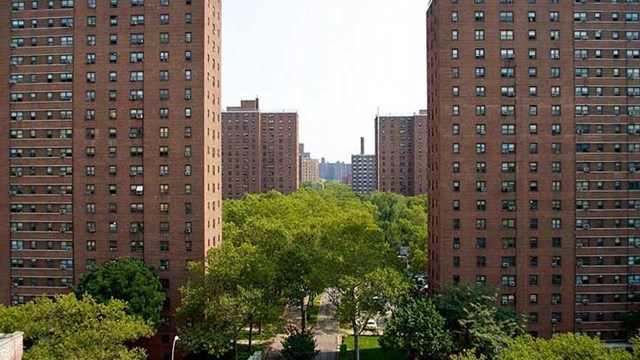Located in the Northeast corner of the Bronx, in the area known as Baychester, sits the largest housing cooperative in the world. Co-op City is home to about 50,000 people; if it suddenly decided to secede from Bronx County, it would be one of the 15 largest cities in the state.
“Co-op City as a stand-alone would be the 10th largest city in New York—it’s massive,” says Herbert Freedman, principal of Marion Scott Real Estate, which oversees the operation of Riverbay Corporation, Co-op City’s management company.
A Long History
Years ago, on the 300-acre plot of marshy land along the west bank of the Hutchinson River where Co-op City now rises, there once was an American history-themed amusement park called Freedomland. The park lasted only four years (from 1960 to 1964) before it filed for bankruptcy and was shuttered permanently.
Prior to Freedomland, the land occupied by Co-op City was reincarnated several times — first as the home of the Siwasnoy Indians, then as a cucumber farm and pickle factory, then as a failed municipal airport. The planning and building of Co-op City began in 1965 after the demolition of Freedomland, with the first apartment building completed in 1968. While the project was officially completed in 1973, some building continued up till the early 1980s.
Co-op City was the largest construction project of the United Housing Foundation (UHF), a non-profit organization created in 1951 to promote consumer cooperatives and housing.
Development and Architecture
Co-op City consists of 15,372 residential units in 35 high-rise buildings and seven three-story townhouse clusters. There are three shopping centers with about 150 stores, and more than 40 offices rented by doctors, lawyers, and other professionals. A 25-acre educational park is home to three elementary schools, two middle schools and Harry S. Truman High School; there is also a weather station, 14 gymnasiums, two swimming pools, a planetarium and the Museum of Migrating Peoples.
The high-rise buildings of Co-op City were designed by Herman Jesser, an architect who advocated “tower-in-the-park” urban renewal. Of the development’s 300 acres, only 20 percent of the land was constructed upon, which left large green areas left open, including a 60-acre greenway that was once the centerpiece of the parkland in Co-op City. (Unfortunately, large portions of the greenway were paved over in 2003 to make space for parking.)
Co-op City also boasts 15 churches and houses of worship, six nursery schools and day care centers, four basketball courts, and five baseball diamonds. Each of the shopping plazas has its own supermarket and a variety of restaurants; Bay Plaza even has its own multiplex movie theater.
Riverbay Corporation
Co-op City is managed by the Riverbay Corporation, which has 32 administrative/operational departments and over 1,000 employees. The corporation is overseen by a 15-member board of elected directors, and presided over by board president Al Shapiro.
Mirande Valbrune, the human resources director of Riverbay, says that because of the large number of employees, the administrative departments primarily serve the needs of Riverbay Corporation, rather than the shareholders themselves. The company’s administrative offices range from financial to legal to human resources, as well as community relations, giving Riverbay a liaison between governmental and community groups. There’s also the sales department, which handles new shareholders, transfers, and sales.
According to Valbrune, the Riverbay employees handle everything having to do with repairs, public safety, upkeep of the grounds, waste management, and the power plant.
Debt and Deterioration
Despite the progressive intentions that originally inspired the developers of Co-op City, the community has had its share of problems over the years—both structural and financial.
Co-op City was built on a marsh. The development’s buildings are supported by over 50,000 pilings extending down into the bedrock, but over the years, the underground utility system—which was laid in landfill trenches—has proven vulnerable to movement and settling. According to Freedman, the settling earth has also caused shear fractures in the buildings’ walls and disrupted stairs and ramps at their entrances.
The initial construction also went over budget, with each unit costing $4,000 more to build than originally anticipated. Adding to that were management issues.
In 1975, the officers of Riverbay Corporation tried to offset the budget deficit by passing along the $4,000-per-apartment overrun to the residents in the form of a 25 percent increase in monthly carrying charges—a move that resulted in a 13-month rent strike. That strike would become the longest and largest in United States history. Eventually the state conceded, and only modest rent hikes were implemented.
The financial issues didn’t end there, however. Over the years, the bills for repairs at Co-op City have climbed, while the buildings themselves have deteriorated. In 1992, the state provided $108 million for repairs—by that point however, the estimated cost for the necessary work was more like $210 million. Vacancies were also increasing around this time, so the state issued the development a $3 million grant to lower the purchase price for apartments. That move proved more successful, and helped bring the vacancy rate down from its all-time high in 1993 of about 1,500 empty apartments.
It wasn’t enough, however. By 2003, says Freedman, the financial and structural situations at Co-op City could not be ignored. Windows needed replacing, the cement terraces were crumbling, elevators needed to be modernized, roofs and brick facades needed repair. On top of all that, the backup generator at the development’s power plant left the community in the dark during the August blackout. The final straw however, came when the greenways were paved over a couple of years ago to make room for the desperately needed parking spaces. The parking situation itself had become dire thanks to the community’s original parking garages being condemned.
Turning the Tide
Clearly, Co-op City was in need of some major help. The first solution came from Albany in 2004 when the New York State Housing Finance Agency (HFA) and the Division of Housing and Community Renewal agreed to refinance Co-op City’s $192 million mortgage and lend Riverbay $275 million for capital repairs. Mayor Michael R. Bloomberg and the city also stepped in and made J-51 benefits available to Co-op City residents, which added savings of $14 million through property tax abatement. Finally, the New York Community Bank gave the community a $480 million loan for still more essential repairs and to pay off the existing balance with the HFA.
Thanks to those infusions of cash and assistance from the city and state, Co-op City has undertaken major improvement projects aimed at rejuvenating the community and preserving residents’ quality of life. According to Freedman, there are currently dozens of works projects in various stages, including two new garages slated to open at the end of 2006, modernization of the complex’s elevators, new windows in every apartment, and rebuilt balconies.
Best of all perhaps, Co-op City’s revamped power plant now includes both gas and steam turbines, with trigeneration being used for everything from hot water to basic electricity.
More Room for Less
Apartments at Co-op City are offered in various sizes with floor plans of three, three-and-a-half, four, four-and-a-half, five, six, and six-and-a-half rooms. Apartments come with an array of standard features and amenities, but purchasers also have the opportunity to select designer options to enhance the finish of the apartment at additional cost.
In 2004, Co-op City’s mortgage was refinanced, resulting in an increase in apartment costs and maintenance charges. In April of 2007, there will be another 1.5 percent increase. The 2006 cost to buy a Co-op City apartment ranges from $10,500 to $22,750, with carrying charges from $512 to $1,109 per month—making it one of the most affordable developments in the city.
In order to obtain and apartment, prospective buyers apply with the Riverbay Corporation for approval. Even with the financial and maintenance challenges of recent years, there are no apartments immediately available in Co-op City. All applications are put on waiting lists, and the current wait time for one- and two-bedroom apartments is approximately two months. Three-bedroom apartments have a longer waiting list.
Since Co-op City is a Mitchell-Lama building, it has a minimum income requirement, making it a residence for primarily middle-income families. The current income requirements range from $22,582 to a maximum income of $123,624 per household; the only exception are lower income requirements for senior citizens 62 years of age or older.
Diverse Dreams
From the beginning, Co-op City was a racially diverse community, with families from a wide array of cultures putting down roots and taking advantage of the development’s resources and affordable housing. While it began with Irish, Italian, and Jewish residents, Co-op City was also home to significant African-American and Latin populations right from the start. Over the years, the face of the Co-op City community has changed, and changed again, from European to Caribbean, but always reflecting a vibrant mix of people from all over the world. Recently, there has been a large influx of Jewish families from the former Soviet Union, looking for a more diverse environment than the predominately Russian neighborhoods of Brighton Beach in Brooklyn.
“It was the first time for such a mixed neighborhood,” says David Chesler, whose family lived in Co-op City from 1970 to 1991.
With a new lease on life and major improvements underway and ongoing, it appears that the diversity and accessibility represented by Co-op City still have a foothold in an otherwise challenging housing market.
Ross Whitsett is a freelance writer living in New York City.







17 Comments
Leave a Comment